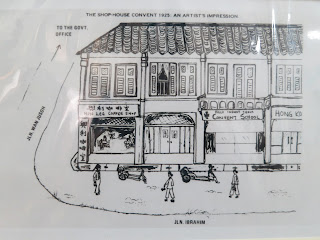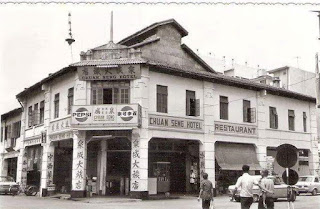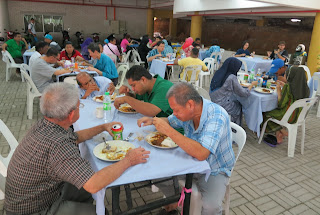While
shopping for Johor souvenirs at Jalan Wong Ah Fook a few years ago, I met local
sketch artist, Taib Aur.
 |
Taib Aur sketching a scene at
Kg Bakar Batu in Tampoi |
His sketches
of portraits, landscapes, buildings and local scenery were so impressive that I
couldn’t resist buying a series of sketches that were reproduced as postcards. Then Taib told me about Buz Walker-Teach, an
American art lecturer with Raffles University Iskandar in Nusajaya, who also stopped
to look at his sketches. Walker-Teach,
better known as Buz, was thrilled to meet a fellow artist who enjoyed sketching
street scenes and their meeting along JB’s main street was the start of a
special bond based on their common love for art.
Starting
Out
Buz would
hang out with Taib regularly, talking about drawing and introduced Taib to the
concept of the Urban Sketchers who sketched from observation or drew pictures
from life. While Taib and other local
drawing enthusiasts each have their own style and choice of drawing or painting
mediums, they share the same passion for going on site to sketch or paint
scenes from real life.
 |
Curious children watching as
Riki Maulana, better known as
Tok Rimau, sketches |
When Buz
presented Taib with a book of sketches by the Urban Sketchers, they were
inspired to start a similar group in Johor with the aim to compile and publish
a book on Johor life and landscapes.
Taib
connected Buz with other drawing enthusiasts in Johor like Mohd Hafizal Nordin,
Eric Ng Han Meng, Riki Maulana who goes by the moniker, Tok Rimau, and they in
turn, invited their own network of artist friends to join them.
These artists share a habit of keeping visual
diaries to record a series of scenes that are viewed from a variety of angles
before they decide on which scene to develop fully with water-colours or other
types of paints. The strong creative
connection bonded this group together and as they adopted the core principles
of the Urban Sketchers to draw from observation and real life, they became
known as the Johor Sketchers.
On-Location
Events
Taib
tells me that the Johor Sketchers is an informal group of artists who just
enjoys hanging out together. They meet
as often as twice a month for on-location events and have made trips to places
like the Batu Pahat, Pontian, Kulai, the Senibong coast, Stulang Laut and
various sites in the city to sketch landscapes, old mansions and iconic
buildings.
 |
The Sultan Abu Bakar Mosque in water
colour by Eric Ng Han Meng |
Eager to have an on-location
experience with them, I asked Taib to keep me posted on their next outing so
that I can join them.
Then I
receive a message from him to go to Kampung Bakar Batu in Tampoi with
directions to the village on the edge of the Danga River where Orang Seletar
fisher-folk are still making a living with fishing and farming mussels.
I arrive to see each artist at his or her
chosen spot with sketch book and pen or pencil in hand, engrossed in recreating
their view on paper. Curious village
children pause in their playing and gather close to the artists to see them sketch
outlines on paper in rapid freehand drawing and watch in fascination, as the
images gradually emerge.
“We get
to know the place by talking to the local people who come to observe us while
we sketch,” said Taib. “This not only
gives us a sense of the place and its history but also a better understanding
of the culture or sentimental value of a building or traditional lifestyle that
is fast disappearing in modern Johor,” he added.
Picture
Preservation
 |
The Wong Ah Fook mansion by Buz Walker Teach
before it was demolished |
Buz, who
has been living in Asia for almost 20 years, has spent more than two years in
JB and is quite familiar with the city sights.
He inspires his students with field trips to places of interest in the
city like the Tan Hiok Nee Heritage Walk where they mingle with the local
people and draw on location.
His
collection of sketches include a precious
sketch of the old mansion popularly known as the Wong Ah Fook mansion, which he
captured in great detail, before it was suddenly demolished.
 |
A traditional Malay house at Jalan Abdul Samad, JB,
by Riki Maulana, better known as Tok Rimau |
“Johor has big aspirations to develop
into a modern metropolis but where will all this go?” Buz asked with reference
to the traditional lifestyle of indigenous people. This is why the sketches of landscapes and
buildings by the artists are a valuable resource in the preservation of a slice
of life and history that is fast disappearing.
“I take a long time to draw a scene because I often stop to talk to
people,” he confessed because he also enjoys talking to observers who cannot
resist asking him questions about his interest in drawing a particular scene.
"When
you sketch, you absorb the soul of that place,” said Riki Maulana, better known as Tok Rimau. He explained that artists usually analyse the scene or structure before starting to sketch. They would make a series of outlines from various angles and pick one that they are most comfortable with before fleshing it out into a complete picture.
 |
Sahrudin Omar, engrossed in
sketching a JB street scene |
He said all of us learnt to draw while we were in kindergarten but somehow lost the skills along the way. Through drawing from real life, the Johor Sketchers are encouraging everyone to rediscover the joys of sketching again.
I can see their enthusiasm and camaraderie as the artists turn the pages of their well-thumbed sketch books to show me their favourite sketches and share various anecdotes on the outings to those destinations. The adage, "A picture is worth a thousand words," rings true as I recognise and reminisce over familiar sites in the collection of sketches they have vividly captures from real life in and around JB.
Taib tells me that the ultimate dream of the Johor Sketchers is to compile their sketches of Johor scenes into a book and preserve them for posterity. For now, he is simply thrilled with how the creative passion of the members is being ignited and honed by each other's energy and creativity. For more info, visit website: www.johorsketchers.blogspot.com
 |
| A boat that Nurul Izzati Ramli saw at Jalan Pantai, Pontian, while fishermen were cleaning up after their day's work |
 |
Sketch of a boat at the Pontian fishing pier by Mohd Hafizal Nordin also includes the figure of fellow
Johor Sketcher, Buz Walker Teach [Right] |
A version of this was published in The New Sunday Times, Life & Times on 16 Aug 2015







































